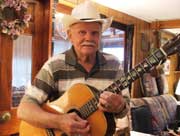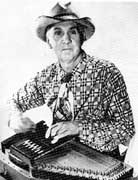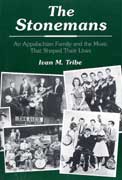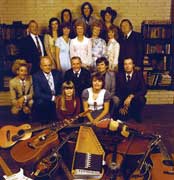|
|
 |
|||||||
|
Volume 13, Issue 33 ~ August 18 - 24, 2005
|
||||||||
 Last Son of a Country-Western Dynasty Last Son of a Country-Western DynastyGene Stoneman was part of a family music legacy spanning more than 100 years by Carrie Steele with Dawn Kittrell THE MOUNTAINEER'S COURTSHIP Mr. and Mrs. Ernest V. Stoneman: Banjos strum and fiddle lines frolic in and out of a lively, thwacking bass. Glossy female and male vocal melodies intertwine in the fast-paced twangy rhythms of the Stoneman Family. That was when Country Music — long before Garth Brooks, Shania Twain, Dunn & Brooks and Montgomery Gentry came on the scene — was drastically, unmistakably country. Chesapeake Country has just lost a relic of that old-style country music. Gene Stoneman of Edgewater, who died at 75 on August 15, 2005, was one of the last of 15 sons and daughters in a family of musicians who played, in different combinations and names, all over Maryland and Virginia — even rising to the Grand Ole Opry in Nashville, Tennessee. The Stonemans’ music gained them fame throughout the kingdom of country music. In Bristol, Tennessee, on the Tennessee-Virginia state line, where the Stonemans made some of their first recordings, there’s a mural 18 feet high, with Pop and Mrs. Stoneman right up there with legendary Jimmy Rodgers and Mr. Carter of Carter Family fame. In Nashville, Pop Stoneman was made an icon in the wax museum. That was back when “Connie Gay was running the show,” said Stoneman in one of a series of interviews over the summer. For the interviews and a portrait class at Edgewater Senior Center, he donned a white cowboy hat in tribute to the Stoneman Family style — cowboy hats, with fringed cowboy shirts and neckerchiefs. Gene and his twin brother, Dean, were in later years a part of the Stoneman Brothers, one of the many offshoots of this musical family. Connie Gay introduced the musical style he christened Country Music to the broader nation, proving its draw with two shows in DAR’s Constitution Hall on October 31, 1947. One act in those landmark shows was the Stoneman Family. The Reigning Family of Country “My family had a different way of playing. Whatever they had, people must have loved it,” Gene Stoneman told Bay Weekly. The family style was rhythmic, steeped in country and spiced with bluegrass, most noticeable in the fast-and-steady fiddling of Scott. The family of musicians had bluegrass roots dating back over 100 years in Appalachia. Pop Stoneman tapped the roots to nourish a musical dynasty. Country music patriarch and pioneer Ernest Van ‘Pop’ Stoneman cut the first-ever country music record in history in 1924. That first got double value as the first recording ever of an autoharp. Okeh Records in New York City recorded the track on an old Victrola cylinder. For this premier, Stoneman chose an epic, original song: “Sinking of the Titanic” — played by Ernest V. Stoneman and the Dixie Mountaineers. After the Mountaineers and into the hard years of the Great Depression, as their family grew, Pop and Hattie Stoneman continued with The Blue Ridge Corn Shuckers and The Pilot Mountaineers. From Tennessee, the struggling family migrated to the D.C. area, eventually finding a home in Prince George’s County. “We moved to Maryland when I was 11 years old,” said Stoneman, twin and middle child born in 1930. Doctors didn’t expect him and twin Dean to live when they weighed in at less than one pound each. Mother Hattie kept them alive in a shoebox and wrapped in hot rags for incubation. Their move to Carmody Hills, Maryland, was in the early 1940s. “I remember plucking on my father’s guitar when I was little,” he recalled. In Carmody Hills, neighbors would gather on their porches to hear the Stonemans practice. “So when the family eventually moved, the neighbors all moved out too,” added wife Peggie Lue Stoneman. By the outbreak of World War II, Pop had earned his title and, with his family by his side, was earning a living. His band of that era, The Stonemans, included his ever-growing family. As well as having children, fiddler Hattie Stoneman kept on playing with the family band. Over the years, a dozen of the children played with the band. “On the weekends we’d play. We started playing in Armstrong’s [Restaurant and Tavern] on Rt. 214, when we were small,” Stoneman said. “We played at Constitution Hall in 1947. We went to play against other musicians and had seven standing ovations. We played ‘Somebody’s Waiting for Me,’ and we tore the house down,” said Stoneman. Then, Peggie Lue recalled, “they asked them not to clap anymore.” Later, in the early 1950s, “we played Charles Hotel in Hughsville every Saturday night for five years. “You get to know a lot of musicians. Everyone came to see The Stonemans play,” Stoneman said. He grew up rubbing elbows with country heroes: Johnny Cash, Roy Acuff, Brother Oswald, Ricky Van Chelton, Chet Atkins and Jimmie Rogers. In 1967, the Stoneman Family won Best Vocal Group at the Country Music Awards. In 1968, their hit song “Christopher Robin” made the Billboard Top 40 country chart for eight weeks. Two motion pictures, plus additional nominations to the Country Music Awards, made The Stonemans heavy-hitters in the league of country music. “They loved their music. That was their life,” said Peggie. In the Stairway of Stars in Tennessee, there are three Stoneman stars: one for the Stoneman family, one for Pop and one for brother Scott. When Pop Stoneman died in 1968, he was buried in Nashville. Johnny Cash sent a guitar-shaped floral arrangement. But the music played on. The Stoneman children kept their guitars strumming and voices blending. They performed in different combinations; appeared on The Jimmy Dean TV Variety Show and hosted their own television program, Those Stonemans. Sister Roni appeared regularly on the country music TV show Hee-Haw in the ’80s, and some of The Stonemans played as guest musicians in 1981, as well. Sister Donna, 71, still sings in churches, Stoneman said.
“I used to hear them play at Jim’s Country Kitchen, on the corner of Cedarhurst and Shady Side Road. Now it’s called Richard’s,” said Ruth Zirnhelt of Broadwater, who, with a girlfriend, saw the Stonemans perform frequently in the mid-1950s, when she was in her mid-30s. “We used to go almost every Sunday. It was wonderful. You’d be lucky to get a parking space within miles of the place. Jim’s would be chock-full of people, but everybody was very friendly. It was like a great big family reunion. And there would be a big sign on the top of the Stoneman car, ‘Pop Stoneman and His Little Pebbles.’ I miss those days,” she said. That was back when the Stoneman kids wore plaid shirts, dungarees, bandanas and straw hats to performances. Each modified the style to his and her own liking as they grew. Gene Stoneman’s lifetime of strumming slowed, but it didn’t stop until he died. He performed as recently as July, when Stoneman joined with sister Roni for a reprise at Hughsville’s Charles Hotel, one of the many stages he used to frequent. “Gene’s played all through the state of Maryland,” said Peggie. The Stonemans played regularly at Armstrong’s, Torry’s, Club Cavakas in D.C., Club Hillbilly in Seat Pleasant and dozens of other stages throughout the region. His performances grew fewer and farther between — and with fewer family members to accompany. What kept audiences coming back was the family’s unique sound. “They had a certain lick in their rhythm,” said Peggie. “And the best thing about our music is we don’t get out of time,” Stoneman said. “If you start in one beat, you don’t get out.” It’s a difference he can hear in today’s musicians. The country music tunes have changed since The Stonemans’ era, which stretches back over a hundred years, explained Peggie. Old country music tells a story, more like a ballad, and has a certain beat, Stoneman explained. “Now it’s rock-a-billy, all jazzed up, and doesn’t tell a story,” Peggie added. Stoneman’s taste in music never strayed too far. “I played bluegrass, but I don’t care for it anymore. I listen to country now,” he said, as well as some rock and roll. “I like Willie Nelson and the Rebels. And of course, Elvis Presley. He was a great musician and singer. Nobody ever sung better than him.”
Gene climbed to the summit of country music, playing the Grand Ole Opry. As well as playing with the whole family, he often played with his brothers: twin brother Dean, Jack Eddy and Billy. “I miss playing with my brothers; they’re all dead,” Stoneman said. “Playing with someone else who’s got a different swing than them” — or didn’t have the same rhythm — just wasn’t the same, he said. Gene’s brother, Scott “was exceptional,” said Peggie. “Scott, he’s going to town now,” she illustrated as a record of the Stonemans’ played in the background. A missing bow didn’t even slow this fiddler: Scott used a coat hanger — and once even a toothpick when someone hid his bow before a performance. “My brother Billy could sing just like Hank Williams,” added Stoneman, of yet another of the four brothers he regularly performed with. Playing didn’t stop even for war. “In 1954 to ’56, I was in the Fourth Infantry division, which went all over Germany,” said Stoneman who afterward served in special services for six months, playing with the Army service band. Back in the States, the music kept entertaining audiences. Performing for audiences wasn’t always easy, even to one who came from such a background. “I used to shake a little bit when I got on stage,” Stoneman said. “But Scott told me that if those people could play as good as you, then they’d be up here on stage and you’d be sitting down there. From then on I didn’t care anymore.” Stoneman always kept his Martin guitar handy. On his 52-year-old Martin D-28, he used a sheetrock knife to engrave the fingerboard with mother-of-pearl hearts and diamonds. He presented his abalone-inlaid Martin guitars — made with Brazilian rosewood — as if he were showing off rare artwork. He also built two upright basses that resemble a large banjo, which he dubbed The Whomper, which resides upstairs, reaching nearly six feet high in its corner by the fireplace. But rhythm guitar remained Stoneman’s specialty. Guitar playing is something that you’re born with, said Stoneman, who used to sneak his father’s guitar off of the living room wall and taught himself to play. “You’ve got to have it in you,” he said. The best part about performing was knowing you know what you’re doing, said Stoneman, who’s always played entirely by ear; he’s a musician who doesn’t read music.  Building Music History Building Music HistoryThe immediate family is much smaller now. Gene was the one of the last surviving of 23 Stoneman children, of whom 15 lived and became family musicians. He passed a part of the Stoneman legacy onto daughter Robin Lewonich, of Lusby, who plays the guitar. On his return to Maryland, Gene Stoneman unlocked other doors. “I knew that if I played music and worked, I’d have it made,” said Stoneman. So he worked in Prince George’s County as a locksmith, carpenter, floor layer, door hanger, furniture maker, finisher and painter — painting as many as seven kitchens in one day, he said. He remodeled the Edgewater home he and Peggie Lue bought in 1968. “It was like a barn when we moved in,” Stoneman said. He redesigned the inside of his home and filled it with relics of his musical life, country roots and family. His home is now a museum of his life. Family photos spanning 100 years fill frames on every surface and line the walls. Hundreds of antique glass bottles, statues of angels and clowns, old shotguns, decorative plates, silk flowers, paintings by family artists, kerosene lamps and even an old wood-burning stove help fill his handmade home. Four-foot-long longhorn steer horns crown doorways, and a wagon wheel-chandelier hangs over a dining room table. “You don’t throw things away, especially if something’s nice,” said Stoneman, who held his family’s country-bluegrass legacy just as dear. “People are always saying ‘I wish I hadn’t thrown that away.’” Upstairs are even more photos, an ox yoke-turned-mirror and a tube gramophone where he plays tube records — black cylinders that look like a small zoom lens for a camera — like the one his father first recorded on in 1924. Home and tubes, records, tapes and even CDs — they’re all monuments now to this family that helped build country into music loved around the world.
|
||||||||
|
|
||||||||
|
© COPYRIGHT 2004 by New Bay Enterprises, Inc. All rights reserved. |
||||||||




 About the Author
About the Author